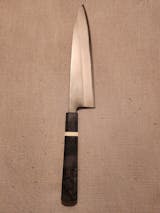The Japanese word Gyuto (牛刀) literally translates to beef sword. The gyuto is the equivalent of the Western chef's knife, and is designed to cut everything: vegetables, meats and fishes. It is made to be used with the push-cut method, lifting the blade between each cutting motion, or with the rocking motion method. It is important that the blade is straight upon impact with the cutting board to avoid damage to the knife edge.
The Yoshikane forge was founded in 1919 in Sanjo/Niigata and is now run by 4th generation Kazuomi Yamamoto-san. He was trained by his uncle Tsuneo Yoshida (3rd generation) and is now established as one of the best blacksmiths in Japan, in addition to being recognized for his skills in blade sharpening. He would rival or surpass the best Sakai sharpeners. This explains why so many talented blacksmiths in Sanjo have been trained at Yoshikane's forge. Yoshikane is famous for its work of Shirogami #2 steel, SKD-11 steel and SLD steel.
Here is a famous quote from Kazuomi Yamamoto-san: "While many things change rapidly these days, there are ideas and beliefs that never change. Every day, I make sure that the meaning of these words is forged in the making of knives".
Shirogami #2 translates to: Shiro (white) and Gami (Steel) and thus; white steel #2. It is named after the color of the package it was wrapped in at Hitachi Metals. The composition of this steel is very pure and contains almost only iron and carbon (1.05%-1.2%). It is in the hands of very experienced blacksmiths that one realizes the enormous potential of Shirogami #2. The quality of the heat treatment and a lower temperature forging are key elements that can allow Shirogami #2 to compete with and even surpass many modern steels. Try a Shiro #2 blade forged by Tanaka-san, Kisuke Manaka-san or Yoshikane Forge and you will see!



















































